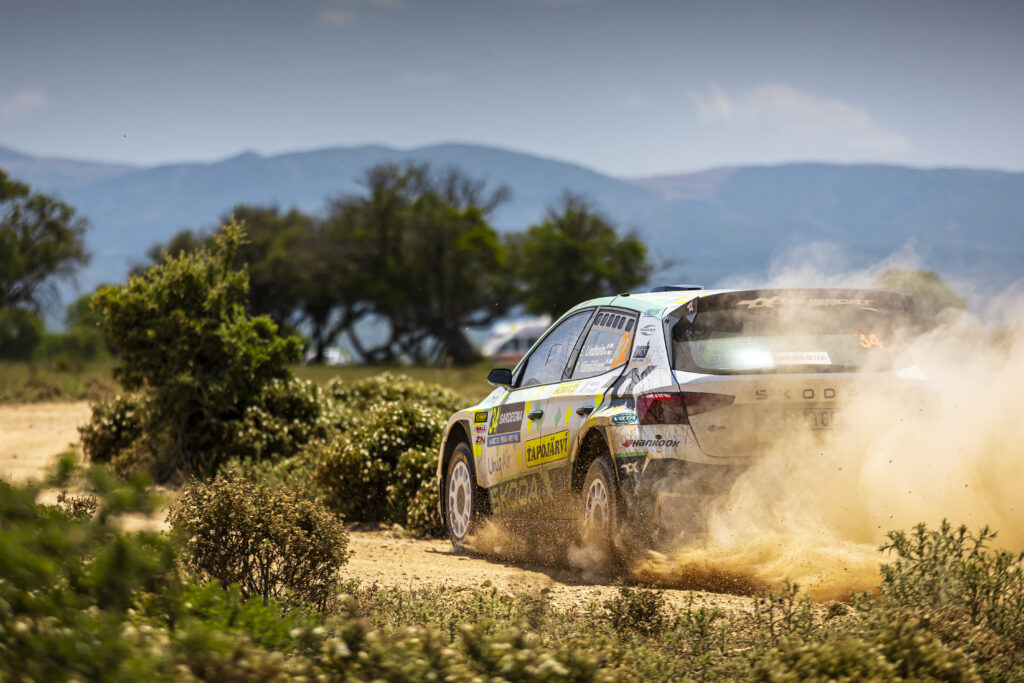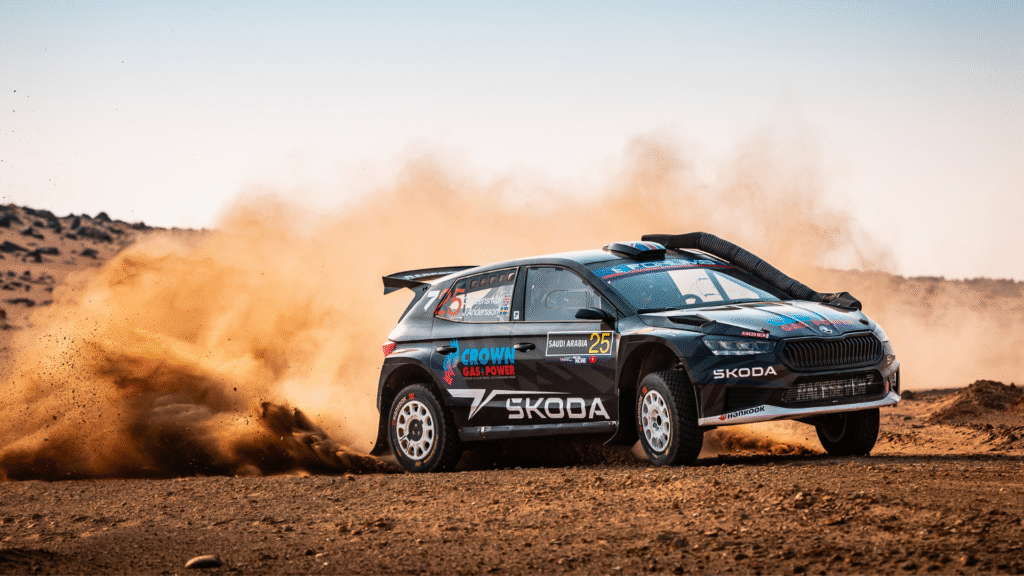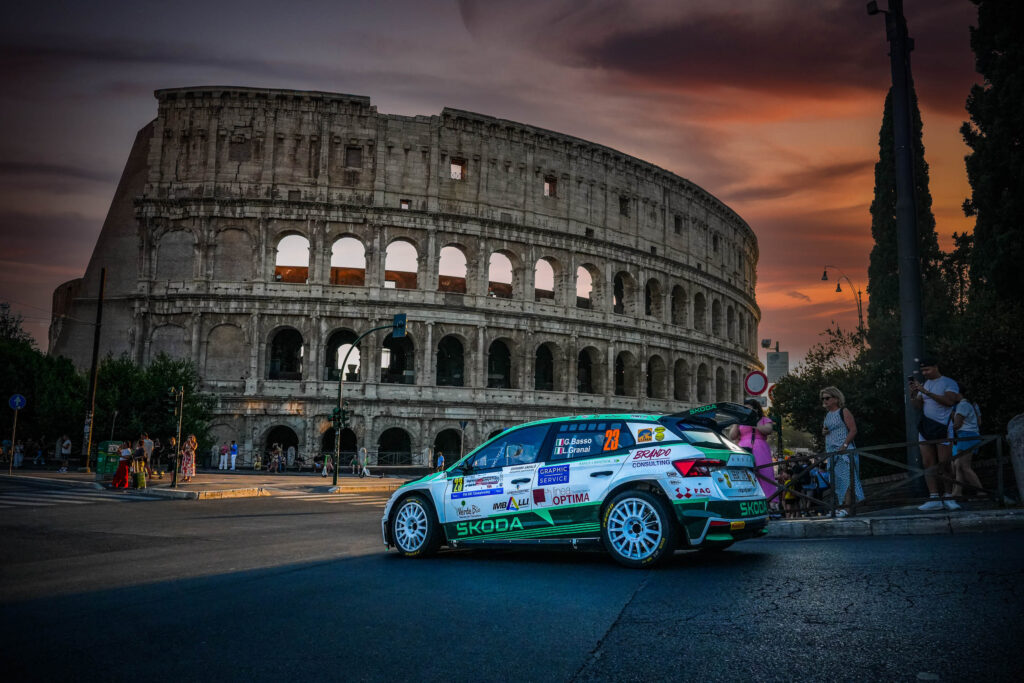It sounds almost like a pirate voyage. The ŠKODA Motorsport team set off on a long trip around Europe, only to return triumphantly back home with gold and silver cups. For the fans, each rally means several days of adventure; for mechanics, engineers and other team members, it’s a much bigger challenge.
The revamped ŠKODA FABIA R5 evo already has two successful starts in the World Rally Championship under its belt. Thanks to the works crews of Kalle Rovanperä – Jonne Halttunen and Jan Kopecký – Pavel Dresler, it scored doubles in Portugal and Sardinia, both in the WRC 2 Pro category and the whole RC2 class. What a lot of people don’t realize is that most of the team took both rallies in one go. The expedition, comprising two large trucks and several support vehicles, first drove from Mladá Boleslav across Europe to Portugal and then headed south, over the sea, to Sardinia. Before it returned home, it had clocked almost 6,000 kilometres on the roads – and that’s not counting the ferries.
“It’s not usual, but sometimes it’s done this way when there are two rallies shortly after one another. If we returned to Czechia after Rally de Portugal, we wouldn’t have enough time to prepare the cars. In the past, we used to link rallies in Sweden and Norway, or in Greece and Sardinia. It’s not easy, though. The boys were on the road for 28 days and didn’t see their families for a whole month”, explains Miroslav Šlambora, coordinator of the rally car and service area preparation.
In these cases, the expedition finds shelter at some of the ŠKODA dealerships abroad for a couple of days. This not only ensures the safety of the precious cargo, but also provides the space for washing and servicing the cars. The most important repairs before the next rally can be done in just two days – one daythe cars are torn apart, the next day they are put back together. Everything necessary is packed in the trucks before departure.
Deserved care
Both Rally de Portugal and Rally Italia Sardegna are counted among the most challenging gravel rallies in the WRC calendar. This year, the weather was extremely hot at both events and the surface of many stages had seriously deteriorated before the second runs. It was really rough on both of the FABIA R5 evo rally cars and they will receive a thorough inspection back in Mladá Boleslav.
“The mechanics will remove gearboxes, differentials, axles and engines. Basically, just the body with the wiring harnesses and hoses will remain; everything else gets taken out. The individual parts then go to various service departments within ŠKODA Motorsport – workshops that specialize in engines, gearboxes or dampers and suspension. The cars are disassembled almost to the last nut and bolt – it’s a bit like building them again from scratch,” explains Šlambora.
Still, this doesn’t mean that you have to “replace half the car” after each rally. On the contrary, most of the components return back to their places after a thorough examination. The longevity and durability of the FABIA R5 and its parts is one of the reasons for its enduring popularity with customer teams, which have to operate on limited budgets. Even so, it’s necessary to check everything, including the body, very carefully, repair any damage, change all the fluids including the gearbox and differential oil, and also replace any parts that are subject to wear, like damaged protective covers.
“This engine can do 2,000 hot kilometres or even more these days. Depending on the level of wear and tear, the engine specialists decide whether to put it back, do a partial rebuild or prepare a new unit. Usually, though, it’s able to keep on going. Similarly, the gearbox and the differentials last for thousands of kilometres and they can be used again, even though it’s sometimes necessary to disassemble and reassemble them as a part of maintenance. The gravel surface causes wear to the suspension arms and axles, which have to be treated and painted - and then they're ready for another race”, explains Šlambora.
After mechanically challenging runssuch as Portugal and Italy, it takes approximately 10 working days to take the cars apart, inspect them, repair or rebuild them and assemble them again. Then, they are ready to challenge for the precious metals once again.
It sounds almost like a pirate voyage. The ŠKODA Motorsport team set off on a long trip around Europe, only to return triumphantly back home with gold and silver cups. For the fans, each rally means several days of adventure; for mechanics, engineers and other team members, it’s a much bigger challenge.
The revamped ŠKODA FABIA R5 evo already has two successful starts in the World Rally Championship under its belt. Thanks to the works crews of Kalle Rovanperä – Jonne Halttunen and Jan Kopecký – Pavel Dresler, it scored doubles in Portugal and Sardinia, both in the WRC 2 Pro category and the whole RC2 class. What a lot of people don’t realize is that most of the team took both rallies in one go. The expedition, comprising two large trucks and several support vehicles, first drove from Mladá Boleslav across Europe to Portugal and then headed south, over the sea, to Sardinia. Before it returned home, it had clocked almost 6,000 kilometres on the roads – and that’s not counting the ferries.
“It’s not usual, but sometimes it’s done this way when there are two rallies shortly after one another. If we returned to Czechia after Rally de Portugal, we wouldn’t have enough time to prepare the cars. In the past, we used to link rallies in Sweden and Norway, or in Greece and Sardinia. It’s not easy, though. The boys were on the road for 28 days and didn’t see their families for a whole month”, explains Miroslav Šlambora, coordinator of the rally car and service area preparation.
In these cases, the expedition finds shelter at some of the ŠKODA dealerships abroad for a couple of days. This not only ensures the safety of the precious cargo, but also provides the space for washing and servicing the cars. The most important repairs before the next rally can be done in just two days – one daythe cars are torn apart, the next day they are put back together. Everything necessary is packed in the trucks before departure.
Deserved care
Both Rally de Portugal and Rally Italia Sardegna are counted among the most challenging gravel rallies in the WRC calendar. This year, the weather was extremely hot at both events and the surface of many stages had seriously deteriorated before the second runs. It was really rough on both of the FABIA R5 evo rally cars and they will receive a thorough inspection back in Mladá Boleslav.
“The mechanics will remove gearboxes, differentials, axles and engines. Basically, just the body with the wiring harnesses and hoses will remain; everything else gets taken out. The individual parts then go to various service departments within ŠKODA Motorsport – workshops that specialize in engines, gearboxes or dampers and suspension. The cars are disassembled almost to the last nut and bolt – it’s a bit like building them again from scratch,” explains Šlambora.
Still, this doesn’t mean that you have to “replace half the car” after each rally. On the contrary, most of the components return back to their places after a thorough examination. The longevity and durability of the FABIA R5 and its parts is one of the reasons for its enduring popularity with customer teams, which have to operate on limited budgets. Even so, it’s necessary to check everything, including the body, very carefully, repair any damage, change all the fluids including the gearbox and differential oil, and also replace any parts that are subject to wear, like damaged protective covers.
“This engine can do 2,000 hot kilometres or even more these days. Depending on the level of wear and tear, the engine specialists decide whether to put it back, do a partial rebuild or prepare a new unit. Usually, though, it’s able to keep on going. Similarly, the gearbox and the differentials last for thousands of kilometres and they can be used again, even though it’s sometimes necessary to disassemble and reassemble them as a part of maintenance. The gravel surface causes wear to the suspension arms and axles, which have to be treated and painted - and then they're ready for another race”, explains Šlambora.
After mechanically challenging runssuch as Portugal and Italy, it takes approximately 10 working days to take the cars apart, inspect them, repair or rebuild them and assemble them again. Then, they are ready to challenge for the precious metals once again.





